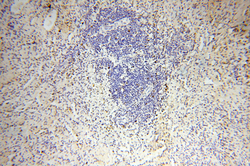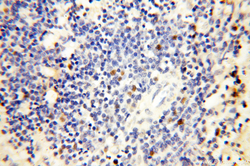Antibody data
- Antibody Data
- Antigen structure
- References [12]
- Comments [0]
- Validations
- Western blot [1]
- Immunohistochemistry [2]
Submit
Validation data
Reference
Comment
Report error
- Product number
- 18051-1-AP - Provider product page

- Provider
- Proteintech Group
- Proper citation
- Proteintech Cat#18051-1-AP, RRID:AB_2265726
- Product name
- DNA Ligase I antibody
- Antibody type
- Polyclonal
- Description
- KD/KO validated DNA Ligase I antibody (Cat. #18051-1-AP) is a rabbit polyclonal antibody that shows reactivity with human, mouse, rat and has been validated for the following applications: IHC, IP, WB,ELISA.
- Reactivity
- Human, Mouse, Rat
- Host
- Rabbit
- Conjugate
- Unconjugated
- Isotype
- IgG
- Vial size
- 20ul, 150ul
Submitted references D-type cyclins regulate DNA mismatch repair in the G1 and S phases of the cell cycle, maintaining genome stability.
Human CST Stimulates Base Excision Repair to Prevent the Accumulation of Oxidative DNA Damage.
CDK-independent role of D-type cyclins in regulating DNA mismatch repair.
hsa_circ_0007919 induces LIG1 transcription by binding to FOXA1/TET1 to enhance the DNA damage response and promote gemcitabine resistance in pancreatic ductal adenocarcinoma.
Cas9-induced large deletions and small indels are controlled in a convergent fashion.
eccDNAs are apoptotic products with high innate immunostimulatory activity.
The histone and non-histone methyllysine reader activities of the UHRF1 tandem Tudor domain are dispensable for the propagation of aberrant DNA methylation patterning in cancer cells.
Biallelic mutations in DNA ligase 1 underlie a spectrum of immune deficiencies.
Nuclear localization of Beclin 1 promotes radiation-induced DNA damage repair independent of autophagy.
Redundant function of DNA ligase 1 and 3 in alternative end-joining during immunoglobulin class switch recombination.
Ligase I and ligase III mediate the DNA double-strand break ligation in alternative end-joining.
DNA ligase I is not essential for mammalian cell viability.
Rona G, Miwatani-Minter B, Zhang Q, Goldberg HV, Kerzhnerman MA, Howard JB, Simoneschi D, Lane E, Hobbs JW, Sassani E, Wang AA, Keegan S, Laverty DJ, Piett CG, Pongor LS, Xu ML, Andrade J, Thomas A, Sicinski P, Askenazi M, Ueberheide B, Fenyö D, Nagel ZD, Pagano M
bioRxiv : the preprint server for biology 2024 Jan 13;
bioRxiv : the preprint server for biology 2024 Jan 13;
Human CST Stimulates Base Excision Repair to Prevent the Accumulation of Oxidative DNA Damage.
Wysong BC, Schuck PL, Sridharan M, Carrison S, Murakami Y, Balakrishnan L, Stewart JA
Journal of molecular biology 2024 Aug 15;436(16):168672
Journal of molecular biology 2024 Aug 15;436(16):168672
CDK-independent role of D-type cyclins in regulating DNA mismatch repair.
Rona G, Miwatani-Minter B, Zhang Q, Goldberg HV, Kerzhnerman MA, Howard JB, Simoneschi D, Lane E, Hobbs JW, Sassani E, Wang AA, Keegan S, Laverty DJ, Piett CG, Pongor LS, Xu ML, Andrade J, Thomas A, Sicinski P, Askenazi M, Ueberheide B, Fenyö D, Nagel ZD, Pagano M
Molecular cell 2024 Apr 4;84(7):1224-1242.e13
Molecular cell 2024 Apr 4;84(7):1224-1242.e13
hsa_circ_0007919 induces LIG1 transcription by binding to FOXA1/TET1 to enhance the DNA damage response and promote gemcitabine resistance in pancreatic ductal adenocarcinoma.
Xu L, Ma X, Zhang X, Zhang C, Zhang Y, Gong S, Wu N, Zhang P, Feng X, Guo J, Zhao M, Ren Z, Zhang P
Molecular cancer 2023 Dec 4;22(1):195
Molecular cancer 2023 Dec 4;22(1):195
Cas9-induced large deletions and small indels are controlled in a convergent fashion.
Kosicki M, Allen F, Steward F, Tomberg K, Pan Y, Bradley A
Nature communications 2022 Jun 14;13(1):3422
Nature communications 2022 Jun 14;13(1):3422
eccDNAs are apoptotic products with high innate immunostimulatory activity.
Wang Y, Wang M, Djekidel MN, Chen H, Liu D, Alt FW, Zhang Y
Nature 2021 Nov;599(7884):308-314
Nature 2021 Nov;599(7884):308-314
The histone and non-histone methyllysine reader activities of the UHRF1 tandem Tudor domain are dispensable for the propagation of aberrant DNA methylation patterning in cancer cells.
Vaughan RM, Kupai A, Foley CA, Sagum CA, Tibben BM, Eden HE, Tiedemann RL, Berryhill CA, Patel V, Shaw KM, Krajewski K, Strahl BD, Bedford MT, Frye SV, Dickson BM, Rothbart SB
Epigenetics & chromatin 2020 Oct 23;13(1):44
Epigenetics & chromatin 2020 Oct 23;13(1):44
Biallelic mutations in DNA ligase 1 underlie a spectrum of immune deficiencies.
Maffucci P, Chavez J, Jurkiw TJ, O'Brien PJ, Abbott JK, Reynolds PR, Worth A, Notarangelo LD, Felgentreff K, Cortes P, Boisson B, Radigan L, Cobat A, Dinakar C, Ehlayel M, Ben-Omran T, Gelfand EW, Casanova JL, Cunningham-Rundles C
The Journal of clinical investigation 2018 Dec 3;128(12):5489-5504
The Journal of clinical investigation 2018 Dec 3;128(12):5489-5504
Nuclear localization of Beclin 1 promotes radiation-induced DNA damage repair independent of autophagy.
Xu F, Fang Y, Yan L, Xu L, Zhang S, Cao Y, Xu L, Zhang X, Xie J, Jiang G, Ge C, An N, Zhou D, Yuan N, Wang J
Scientific reports 2017 Mar 27;7:45385
Scientific reports 2017 Mar 27;7:45385
Redundant function of DNA ligase 1 and 3 in alternative end-joining during immunoglobulin class switch recombination.
Masani S, Han L, Meek K, Yu K
Proceedings of the National Academy of Sciences of the United States of America 2016 Feb 2;113(5):1261-6
Proceedings of the National Academy of Sciences of the United States of America 2016 Feb 2;113(5):1261-6
Ligase I and ligase III mediate the DNA double-strand break ligation in alternative end-joining.
Lu G, Duan J, Shu S, Wang X, Gao L, Guo J, Zhang Y
Proceedings of the National Academy of Sciences of the United States of America 2016 Feb 2;113(5):1256-60
Proceedings of the National Academy of Sciences of the United States of America 2016 Feb 2;113(5):1256-60
DNA ligase I is not essential for mammalian cell viability.
Han L, Masani S, Hsieh CL, Yu K
Cell reports 2014 Apr 24;7(2):316-320
Cell reports 2014 Apr 24;7(2):316-320
No comments: Submit comment
Supportive validation
- Submitted by
- Proteintech Group (provider)
- Main image

- Experimental details
- HepG2 cells were subjected to SDS PAGE followed by western blot with 18051-1-AP(LIG1 antibody) at dilution of 1:500
- Sample type
- cell line
Supportive validation
- Submitted by
- Proteintech Group (provider)
- Main image

- Experimental details
- Immunohistochemical of paraffin-embedded human spleen using 18051-1-AP(LIG1 antibody) at dilution of 1:100 (under 10x lens)
- Sample type
- tissue
- Submitted by
- Proteintech Group (provider)
- Main image

- Experimental details
- The DNA Ligase I antibody from Proteintech is a rabbit polyclonal antibody to a recombinant protein of human DNA Ligase I. This antibody recognizes human,mouse,rat antigen. The DNA Ligase I antibody has been validated for the following applications: ELISA, WB, IHC analysis.
 Explore
Explore Validate
Validate Learn
Learn Western blot
Western blot ELISA
ELISA